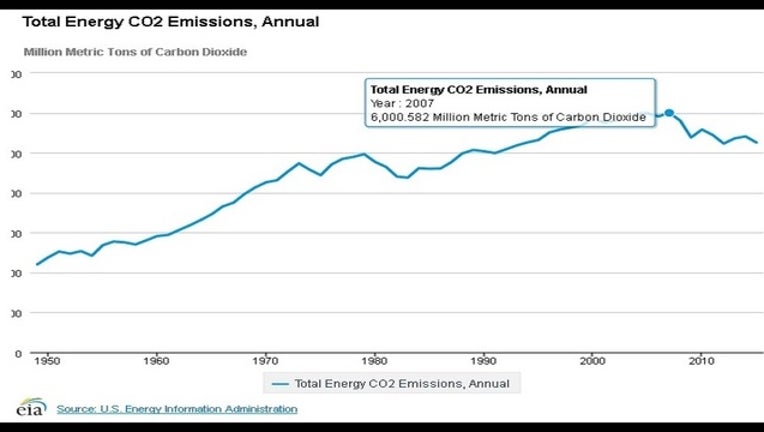U.S. carbon emissions continue their decline

(KMSP) - A new report by the U.S. Department of Energy shows that carbon dioxide emissions in the U.S. are down in 2016, hitting their lowest point since 1991 for the first 6 months of the year and are expecting the lowest emissions overall since 1992. This continues our downward trend since the peak year of 2007.
In the first half of the year, energy related carbon dioxide emissions fell 5 percent compared to the first half of 2015, while overall energy use fell 2 percent during that time frame. Not to mention, residential natural gas use fell 13 percent for the same time period as the year before. The report goes on to claim that a “warm” winter had a big part of it, and while that is likely part of the cause, it’s not the whole story.
Just by looking at our total energy graph, you can make a number of conclusions. For example, the winter of 2012 remains to be the warmest on record in the United States by a LARGE margin with 2014 being SIGNIFICANTLY colder… in fact, one of the coldest EVER for the lower 48 states. Yet, if you look at our graph, there is very little change. While overall CO2 emissions came up in 2014, they didn’t spike. They came up roughly 4% in 2 years. But 2010 was also cold and snowy, but not anywhere close to as cold as 2014, yet somehow we had more overall CO2 emissions in 2010 than 2014. Clearly weather is not the key ingredient in overall CO2 emission trends, it is one of dozens.
Technology is a big part. Since 2007, the use of renewable energy like solar and wind power has gone up a hundred fold, or more. In Minnesota alone, a third of all energy produced in the state now comes from renewables. In 2007, it was less than 5 percent. In fact, Xcel energy has recently announced plans to build several more wind farms and solar power plants. Enough that more than half of all energy produced in the state will be from renewables by 2025. That’s huge!!
Not to mention, we are far more energy efficient than we’ve ever been. Light bulbs are the big reason consuming just a fraction of the energy that they used to, but most household appliances now use far less energy than just 10 years ago.
But a factor that you may have missed is actually the economy. The stock market crashed and the recession started in 2008. Guess where the biggest decline of energy emissions is? Yep, 2007 to 2008 saw an 11% drop in overall emissions. Same thing happened in the recession back in the late 70s and early 80s. So why does the economy play a role?? During a recession, we find a way to spend less. We take fewer trips, which cuts gas emissions from cars and planes. We don’t keep our house as warm in the winter or as cool in the summer… that cuts down on power consumption, which then cuts down on emission. We buy less expensive food like meat and dairy… both of which are very large CO2 emitters.
So MANY things play a role in overall emissions, but the good sign, regardless of the cause is that they are showing a slow decline over the last several years despite the fact that U.S. population continues to grow. With more and more renewable energy coming online in the next few years, and with most of us far more aware of what we are throwing away, regardless whether it’s into the ground or into the air, I bet this graph continues to decline slowly in the years to come.

